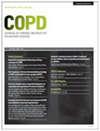轻中度COPD患者上肢无氧代谢能力降低
IF 2.1
4区 医学
Q3 RESPIRATORY SYSTEM
COPD: Journal of Chronic Obstructive Pulmonary Disease
Pub Date : 2022-05-20
DOI:10.1080/15412555.2022.2079485
引用次数: 0
摘要
关于上肢运动时无氧代谢能力对GOLD 1和GOLD 2 COPD患者的作用的信息有限。我们的目的是比较男性COPD患者与健康受试者在30秒Wingate无氧测试(WAnT)期间上肢无氧能力、血乳酸浓度、心血管和呼吸反应。还计算了疲劳率和功率输出衰减的时间常数(τ, tau),并建立了回归分析模型来评估这些患者τ的预测因子。24名男性COPD患者(支气管扩张剂后FEV1 73.2±15.3%的预测)和17名健康受试者(FEV1 103.5±10.1%的预测)接受了WAnT。测量分别在静息时、WAnT结束时以及恢复时间3 '和5 '进行。COPD患者的峰值功率(p = 0.04)、低功率(p = 0.002)和平均功率输出(p = 0.008)均显著低于健康受试者。两组患者的功率输出均呈指数级下降,但COPD患者的速度明显更快(p = 0.007)。功率衰减的时间常数与电阻(欧姆)和无脂质量相关(r2 = 0.604,调整后r2 = 0.555, p = 0.002)。健康人血乳酸浓度在试验结束时及恢复时间3′、5′时均显著高于对照组(p < 0.01)。与健康受试者相比,GOLD 1和GOLD 2 COPD患者在最大强度运动时上肢无氧能力较低,功率输出下降速度更快。此外,WAnT被证明是测量这些患者上肢无氧能力的有效工具。本文章由计算机程序翻译,如有差异,请以英文原文为准。
Upper Limb Anaerobic Metabolism Capacity is Reduced in Mild and Moderate COPD Patients
Abstract Limited information is available regarding the role of anaerobic metabolism capacity on GOLD 1 and 2 COPD patients during upper limb exercise. We aimed to compare the upper limb anaerobic power capacity, blood lactate concentration, cardiovascular and respiratory responses, in male COPD patients versus healthy subjects during the 30-s Wingate anaerobic test (WAnT). The rate of fatigue and time constant of the power output decay (τ, tau) were also calculated and a regression analysis model was built to assess the predictors of τ in these patients. Twenty-four male COPD patients (post-bronchodilator FEV1 73.2 ± 15.3% of predicted) and 17 healthy subjects (FEV1 103.5 ± 10.1% of predicted) underwent the WAnT. Measurements were performed at rest, at the end of the WAnT, and during 3′ and 5′ of recovery time. Peak power (p = 0.04), low power (p = 0.002), and mean power output (p = 0.008) were significantly lower in COPD patients than in healthy subjects. Power output decreased exponentially in both groups, but at a significantly faster rate (p = 0.007) in COPD patients. The time constant of power decay was associated with resistance (in ohms) and fat-free mass (r 2 = 0.604, adjusted r 2 = 0.555, and p = 0.002). Blood lactate concentration was significantly higher in healthy subjects at the end of the test, as well as during 3′ and 5′ of recovery time (p < 0.01). Compared with healthy subjects, COPD patients with GOLD 1 and 2 presented lower upper limb anaerobic capacity and a faster rate of power output decrease during a maximal intensity exercise. Also, the WAnT proved to be a valid tool to measure the upper limb anaerobic capacity in these patients.
求助全文
通过发布文献求助,成功后即可免费获取论文全文。
去求助
来源期刊

COPD: Journal of Chronic Obstructive Pulmonary Disease
RESPIRATORY SYSTEM-
CiteScore
4.40
自引率
0.00%
发文量
38
审稿时长
6-12 weeks
期刊介绍:
From pathophysiology and cell biology to pharmacology and psychosocial impact, COPD: Journal Of Chronic Obstructive Pulmonary Disease publishes a wide range of original research, reviews, case studies, and conference proceedings to promote advances in the pathophysiology, diagnosis, management, and control of lung and airway disease and inflammation - providing a unique forum for the discussion, design, and evaluation of more efficient and effective strategies in patient care.
 求助内容:
求助内容: 应助结果提醒方式:
应助结果提醒方式:


